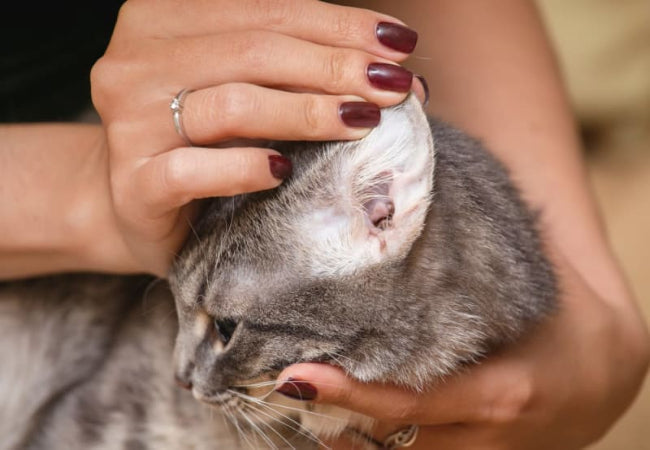Ear Mites in Cats 2025: Signs, Treatment & Prevention 🐱✨

In this article
Ear Mites in Cats 2025: Signs, Treatment & Prevention 🐱✨
By Dr. Duncan Houston BVSc
If your cat is scratching their ears nonstop or shaking their head like something’s inside—it could be ear mites. These tiny parasites are incredibly itchy, highly contagious, and surprisingly common—especially in kittens and rescue cats.
I’m Dr. Duncan Houston, veterinarian and founder of Ask A Vet. Here’s how to tell if your cat has ear mites, how to treat them safely, and what to do to stop them from coming back.
🔍 What Are Ear Mites?
- Microscopic parasites (Otodectes cynotis) that live in the ear canal
- Feed on skin debris and wax, causing intense itching and inflammation
- Highly contagious to other pets (especially other cats, ferrets, dogs)
🚩 Signs of Ear Mites in Cats
- Frequent scratching at ears
- Head shaking or tilting
- Dark brown/black wax buildup (looks like coffee grounds)
- Scabs or hair loss around ears from scratching
- Redness or inflammation inside the ear
🎯 How They’re Diagnosed
- Ear swab examined under a microscope (cytology)
- Sometimes visible crawling mites in severe infestations
💊 Treatment Options
1. Prescription Spot-On Medications
- Revolution (selamectin), Advocate (moxidectin), or Bravecto
- Treat both the ears and prevent re-infestation systemically
2. Topical Ear Drops
- Miticidal drops (e.g., Tresaderm, Otomite) prescribed by vets
- Require daily application for 7–10 days, sometimes longer
3. Treat All Pets in the Household
- Even if they’re not showing symptoms—especially other cats
🧼 Home Care Tips
- Clean bedding, toys, and grooming tools with hot water
- Vacuum regularly during treatment
- Gently clean ears with a vet-approved cleanser (never hydrogen peroxide)
🛑 What Not to Do
- Don’t use over-the-counter ear mite meds without vet approval—many are ineffective or harsh
- Don’t insert Q-tips deep into the ear canal (risk of injury)
🔁 How to Prevent Future Ear Mite Infections
- Use monthly flea/parasite preventatives that cover mites
- Quarantine new cats for 7–10 days and check for ear issues
- Regular vet check-ups and grooming
🔗 Tools from Ask A Vet
- Ask A Vet – Upload ear photos or videos and get a vet diagnosis fast
📋 Summary Excerpt
Ear mites are tiny parasites that cause major discomfort. A vet explains how to spot, treat, and prevent ear mites in cats—especially rescues and kittens.
❓ FAQs
-
Q: Can indoor cats get ear mites?
A: Yes. Ear mites are highly contagious and can spread from contact with other pets, shared bedding, or humans carrying them indoors on clothes. -
Q: Can humans catch ear mites from cats?
A: It’s very rare, but possible. They don’t typically survive on humans, but they can cause temporary itching. -
Q: Are ear mites dangerous?
A: While not deadly, untreated infestations can lead to secondary infections, ruptured ear drums, or chronic discomfort.






